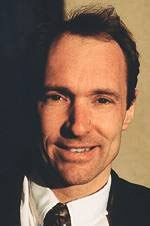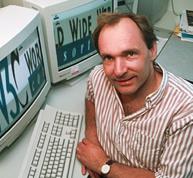351 Tim Berners-Lee
|
us uk web page Sir Timothy Berners-Lee KBE, FRS, FRAEng. Tim Berners-Lee graduated from the Queen's College at Oxford University, England, 1976. Whilst there he built his first computer with a soldering iron, TTL gates, an M6800 processor and an old television. He spent two years with Plessey Telecommunications Ltd (Poole, Dorset, UK) a major UK Telecom equipment manufacturer, working on distributed transaction systems, message relays, and bar code technology. In 1978 Tim left Plessey to join D.G Nash Ltd (Ferndown, Dorset, UK), where he wrote among other things typesetting software for intelligent printers, and a multitasking operating system. A year and a half spent as an independent consultant included a six month stint (Jun-Dec 1980)as consultant software engineer at CERN, the European Particle Physics Laboratory in Geneva, Switzerland. Whilst there, he wrote for his own private use his first program for storing information including using random associations. Named "Enquire", and never published, this program formed the conceptual basis for the future development of the World Wide Web. From 1981 until 1984, Tim worked at John Poole's Image Computer Systems Ltd, with technical design responsibility. Work here included real time control firmware, graphics and communications software, and a generic macro language. In 1984, he took up a fellowship at CERN, to work on distributed real-time systems for scientific data acquisition and system control. Among other things, he worked on FASTBUS system software and designed a heterogeneous remote procedure call system. In 1989, he proposed a global hypertext project, to be known as the World Wide Web. Based on the earlier "Enquire" work, it was designed to allow people to work together by combining their knowledge in a web of hypertext documents. He wrote the first World Wide Web server, "httpd", and the first client, "WorldWideWeb" a what-you-see-is-what-you-get hypertext browser/editor which ran in the NeXTStep environment. This work was started in October 1990, and the program "WorldWideWeb" first made available within CERN in December, and on the Internet at large in the summer of 1991. Through 1991 and 1993, Tim continued working on the design of the Web, coordinating feedback from users across the Internet. His initial specifications of URIs, HTTP and HTML were refined and discussed in larger circles as the Web technology spread. In 1994, Tim founded the World Wide Web Consortium at the Laboratory for Computer Science (LCS) at the Massachusetts Institute of Technology (MIT). Since that time he has served as the Director of the World Wide Web Consortium which coordinates Web development worldwide, with teams at MIT, at INRIA in France, and at Keio University in Japan. The Consortium takes as its goal to lead the Web to its full potential, ensuring its stability through rapid evolution and revolutionary transformations of its usage. The Consortium may be found at http://www.w3.org/. In 1999, he became the first holder of the 3Com Founders chair at LCS, and is now a Senior Research Scientist within the Lab. The Lab merged with the AI lab to became "CSAIL", the Computer Science and Artificial Intelligence Laboratory at MIT. He is the author of "Weaving the Web", on the the past present and future of the Web. -------------------------------------------------------------------------------- Awards In 1995, Tim Berners-Lee received the Kilby Foundation's "Young Innovator of the Year" Award, and an honorary Prix Ars Electronica, and was corecipient of the ACM Software Systems Award. In 1997 he was awarded the IEEE Koji Kobayashi Computers and Communications Award, the Duddell Medal of the Institute of Physics, the Interactive Services Association's Distinguished Service Award, the MCI Computerworld/Smithsonian Award for Leadership in Innovation, The International Communication Institute's Columbus Prize, and an OBE. In 1998, he received the Charles Babbage award, the Mountbatten Medal of the National Electronics Council, the Lord Lloyd of Kilgerran Prize from the Foundation for Science and Technology, PC Magazine Lifetime Achievement Award in Technical Excellence, a MacArthur Fellowship and The Eduard Rhein technology award. In 1999, Time magazine dubbed him one of the 100 greatest minds of the century and he received a World Technology Award for Communication Technology, and an Honorary Fellowship to the Society for Technical Communications. In 2000, he received the Paul Evan Peters Award of ARL, Educause and CNI, the Electronic Freedom Foundation's pioneer award, and the George R Stibitz Computer Pioneer award at the American Computer Museum, and the Special Award for Outstanding Contribution of the World Television Forum.In 2001 he received the Sir Frank Whittle Medal from the Royal Academy of Engineering. In 2002 he was the recipient of the Japan Prize from the Science and Technology Foundation of Japan.He shared the Prince of Asturias Foundation Prize for Scientific and Technical Research with with Larry Roberts, Rob Kahn and Vint Cerf; became a Fellow of the Guglielmo Marconi Foundation, and received the Albert Medal of the Royal Society for the encouragement of Art, Manufactures and Commerce (RSA). In 2004 Tim was listed in the new year's honours list for a knighthood (KBE) for services to the global development of the Internet and was awarded the first Millennium Technology Prize. He was knighted by H.M. the Queen on 16th July, 2004. He has honorary degrees from the Parsons School of Design, New York (D.F.A., 1996) , Southampton University (D.Sc., 1996), Essex University (D.U., 1998) Southern Cross University (1998), the Open University (D.U., 2000), Columbia University (D.Law, 2001), Oxford University (2001) and The University of Port Elizabeth (DSc). He is a Distinguished Fellow of the British Computer Society, and a Honorary Fellow of the Institution of Electrical Engineers., a member of the American Academy of Arts and Sciences, a Fellow of the Royal Society (2001) and a member of the American Philosophical Society (2004). Publications Berners-Lee, T.J., et al, "World-Wide Web: Information Universe", Electronic Publishing: Research, Applications and Policy, April 1992. Berners-Lee T.J., et al, "The World Wide Web", Communications of the ACM, August 1994. Tim Berners-Lee with Mark Fischetti, Weaving the Web, Harper San Francisco, 1999 Education The Queen's College, Oxford University, England, BA Hons (I) Physics, 1973-1976. Emanuel School, London 1969-73 Born London, England, 8 June 1955 |


|
Languages: |
References: |